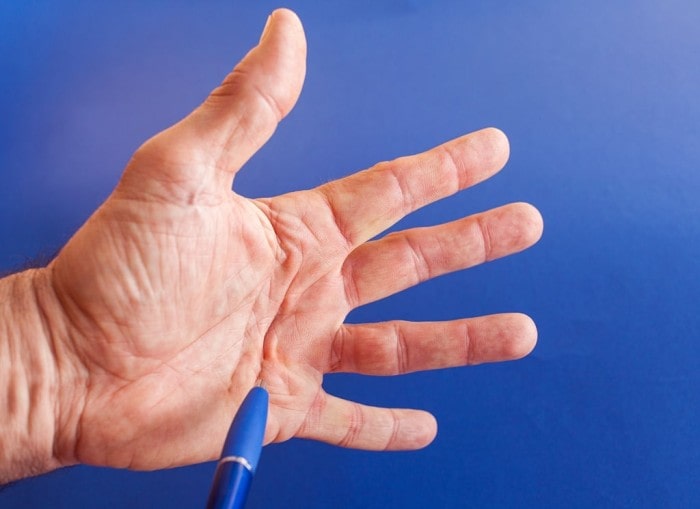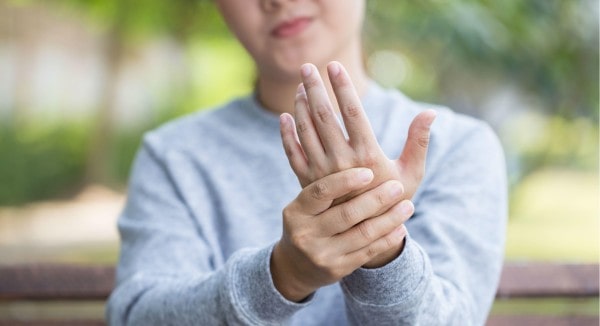
People living with Dupuytren’s Contracture often refuse to acknowledge the first stages of the condition, slowly and unintentionally adapting around the problem. The realization that they have Dupuytren’s Contracture is a surprise when individuals suddenly experience difficulty in performing activities. Once aware of the problem, they seek guidance but often remain confused about the condition and the cure.
How Dupuytren’s Contracture affects quality of life and the ability to do everyday tasks?
If your condition reaches the contracture phase, i.e. permanently bent fingers (which many cases of Dupuytren’s Contracture do if untreated), it can have a significant negative impact on your quality of life.
Advanced contracture pulls on your ring and little fingers until they are wedged in a closed, bent position. It means you can only use your index finger, middle finger and thumb. Everyday tasks, like cooking, texting, driving, exercising, shaking hands and other essential tasks involving the hand, become very difficult.
Symptoms of Dupuytren’s Contracture
Dupuytren’s Contracture occurs when there is a build-up of abnormal tissue beneath the skin in the palm of your hand. It can cause bumps, pits and thick chords that can force fingers to bend involuntarily.
It often causes stuck or bent fingers, particularly the ring and little finger. It can affect more than one finger or both hands at the same time.
Here are the most common symptoms of Dupuytren’s Contracture:
- Popping or clicking when you use your fingers.
- Stiff fingers, particularly in the morning.
- Fingers get stuck in a bent position.
- Pain, tenderness or bumps in the palm at the base of your fingers.
Patient experiences of living with Dupuytren’s Contracture
People fighting with Dupuytren’s Contracture are a valuable source of information for all new people experiencing the disease.
Dupuytren’s Contracture is a chronic, progressive deformity of the hand that limits the active extension of fingers due to advancing, irreversible flexion deformity. It is estimated that two million people are affected by Dupuytren’s disease in the UK.

In some patients, a worsening Dupuytren’s Contracture can interfere with hand function, making it hard for them to perform daily activities. When this occurs, surgical and non-surgical treatments for Dupuytren’s Contracture are available to slow the disease’s progression, and improve motion in the affected fingers.
The findings revealed that people living with Dupuytren’s Contracture receive little information about their condition and possible treatment from health professionals. However, high quality, accurate information from top specialists is required for patients to understand their condition and the treatment options available.
How to make living with Dupuytren’s Contracture easier or less painful
Once you have Dupuytren’s Conreacture, the only way to reduce its effects is through medical treatment. However, there are few things you can do to lessen the pain and impact it has on your day-to-day life.
Protect your hands
The disease begins from the skin on the palm of your hand. Doing exercises or tasks that put extra stress or force on your hands can be uncomfortable and cause further damage.
- Avoid activities that cause repeated gripping or straining of your fingers.
- Wear padded gloves during chores or housework.
- Talk to a physical therapist about other ways to protect your hands.
- Dupuytren’s tape minimizes the amount of pressure being placed on the affected hand.
Do post-treatment physical therapy
Strict post-operative observation and care are imperative to avoid or treat complications. Doing physical therapy after receiving treatment for Dupuytren’s Contracture heals and recovers the process.
- A selective approach is advised, depending on the type of disease and extent of involvement of the hand.
- Products with anti-inflammatory ingredients may be helpful.
- Do gentle massage to improve mobility and daily function that you continue to do on your own.
- Do exercises that directly target your hand and fingers to alleviate the contracture.
Eliminate smoking tobacco and drinking alcohol
Smoking tobacco and excess consumption of alcohol result in microvascular impairment that increases the risk of developing Dupuytren’s Contracture
- Reduce the risk of developing certain cancers.
- Improve lung function.
- Reduce the risk of developing diabetes.
- Improve cardiovascular function.
Reduce inflammation through diet and supplements
Certain foods can probably contribute to your symptoms. Try adding vitamins, spices and minerals to your diet as it helps in reducing inflammation.
- Vitamin E protects the body’s cells from damage.
- Zinc plays a vital role in a healthy immune system and wound healing.
- Magnesium is a vital part of any diet.
- Turmeric is widely used for its anti-inflammatory properties.
The most common non-surgical treatments for Dupuytren’s Contracture
-
Steroid injection
Corticosteroids are anti-inflammatory medications that are inserted into a painful nodule. In most cases, a corticosteroid injection may slow the development of a contracture. However, the effectiveness of a steroid injection differs from patient to patient.
-
Dupuytren’s wand and tape
Dupuytren’s tape is an easy-to-use home treatment that improves the range of motion in your hand. It is designed to last through the wettest, harshest conditions. The extra-strong, synthetic microfiber provides more support for finger joints.
-
Dupuytren’s jelly
Dupuytren’s jelly is a self-heating jelly that not only eases the discomfort that comes with Dupuytren’s Contracture, but also contributes to an inexpensive, feasible alternative to Dupuytren’s surgery. It uses ultrasound and far-infrared radiation to maximize the blood flow to the area.
Benefits of using non-surgical treatments
- Provide safe, effective ultrasound frequency treatment to soften the tissue formed beneath the palm.
- Supports and encourages the finger to open with a gentle stretch.
- Dupuytren’s jelly and wand work hand-in-hand for the perfect combination of at-home treatment methods for the disease.
The treatment of Dupuytren’s Contracture can be done to some extent at home. The best non-surgical treatments for Dupuytren’s Contracture include Dupuytren’s wand, jelly and tape. The three products are proven to lessen the symptoms of Dupuytren’s Contracture without any side effects. They will begin working after one use and can eliminate the condition in only three weeks.
Author Bio:
Gabriel Luis is a specialist blogger in natural remedies for diseases. Certified and by profession, a medical consultant, his passion is to drive health-based decision making with proven facts. While not at clinic, he can be found sharing his expertise on Dupuytren’s Contracture online through blogging mediums.
